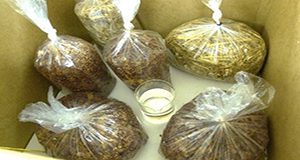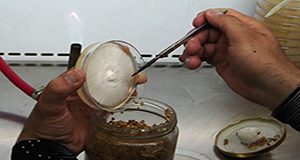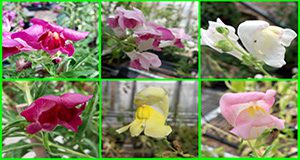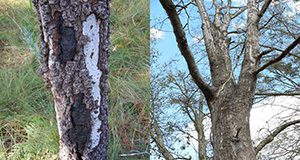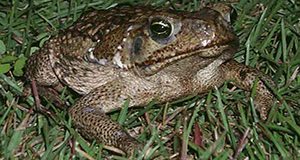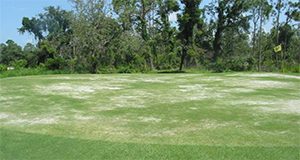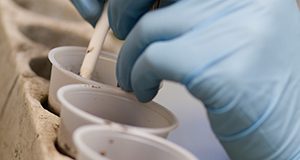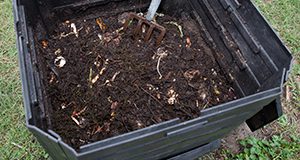La grama o césped St. Augustine está muy adaptada a las zonas calurosas y húmedas (subtropicales) del mundo. Se cree que es nativa de las regiones costeras del Golfo de México y del Mediterráneo. St. Augustine es la especie de grama más usada en Florida. This is the Spanish-language version of ENH5/LH010, St. Augustinegrass for Florida Lawns. St. Augustinegrass is the most commonly-used lawn grass in Florida. This 10-page document describes its cultivation and management for Florida lawns. Written by L. E. Trenholm, J. B. Unruh, T. W. Shaddox, C. Balerdi, and H. Mayer and published by the UF/IFAS Department of Environmental Horticulture, January 2018.
http://edis.ifas.ufl.edu/ep552
Category: Lawn & Garden
D.I.Y. FunGuide: Grow Your Own Oyster Mushrooms at Home
Oyster mushrooms are commonly found on hardwoods throughout the north temperate zone; they are edible and have many nutritious qualities. This 5-page document describes how you can grow your own oyster mushrooms at home. Written by Chih-Ming Hsu, Khalid Hameed, Van T. Cotter, and Hui-Ling Liao and published by the UF/IFAS Department of Soil and Water Sciences, January 2018.
http://edis.ifas.ufl.edu/ss662
Isolation of Mother Cultures and Preparation of Spawn for Oyster Mushroom Cultivation
This 6-page publication details the cultivation of oyster mushrooms from mother culture isolation to spawn preparation. This protocol can be used by both homeowners and commercial cultivators. Written by Chih-Ming Hsu, Khalid Hameed, Van T. Cotter, and Hui-Ling Liao and published by the UF/IFAS Department of Soil and Water Sciences, January 2018.
http://edis.ifas.ufl.edu/ss663
The Fate of Nitrogen Applied to Florida Turfgrass
The quality of Florida’s surface and ground waters is of utmost importance to the flora and fauna living in them, as their growth is directly related to the amount of nutrients in these waters. In order to make informed decisions regarding nitrogen (N) applications to turfgrass, it is important to understand the N cycle in the soil/turfgrass system. The objective of this 8-page publication is to identify and describe the sources and potential fates of N applied to Florida turfgrass. Written by T.W. Shaddox and J.B. Unruh and published by the UF/IFAS Department of Environmental Horticulture, January 2018.
http://edis.ifas.ufl.edu/ep546
Planting and Propagation of Snapdragons in Florida
Snapdragons are a common plant in Florida landscapes and are one of the top ten fresh-cut flowers in the nation. This 5-page publication, written by Heqiang Huo and Jianjun Chen, explores the planting and propagation of snapdragons in Florida landscapes. Published by the UF/IFAS Department of Environmental Horticulture, January 2018.
http://edis.ifas.ufl.edu/ep549
Iron for Florida Turfgrasses
Iron (Fe) is commonly applied to enhance turfgrass color. Understanding the dynamics of Fe both in the plant and in the soil could greatly enhance your nutrient management programs. The objective of this 4-page publication is to explain the function of Fe within the plant, describe the Fe sources available for turfgrasses, and identify which forms of Fe are most effective in improving turfgrass quality. Written by Travis Shaddox and J.B. Unruh and published by the UF/IFAS Department of Environmental Horticulture, January 2018.
http://edis.ifas.ufl.edu/ep551
Understanding Good Irrigation and Fertilization Behaviors Among Households Using Landscape Design Features
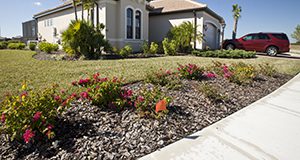
With increasing concerns over water resources in Florida, Extension can target households with irrigated landscapes to encourage practices that protect water quality and quantity. This document compares the water conservation education needs of different Florida household subgroups. Written by Anil Kumar Chaudhary and Laura A. Warner and published by the UF/IFAS Department of Agricultural Education and Communication, January 2018.
http://edis.ifas.ufl.edu/wc292
Impervious Surface Thresholds and the Pace to Plant Technique for Planting Urban Red Maple Trees

A foundation of integrated pest management (IPM) in urban landscapes is to put the right plant in the right place. This preventive tactic can reduce plant stress, pest infestations, and subsequent pesticide applications. Many urban tree species have more insect and mite pests in urban landscapes than in surrounding natural areas. This is due in part to stress created by impervious surfaces like roads and sidewalks that make the air hot and the soil dry. For red maples (Acer rubrum), more impervious surface area adds stress and worsens tree condition. This 4-page publication written by Adam G. Dale, Steven D. Frank, Elsa Youngsteadt, Barbara Fair, Julieta Sherk, and Michael Just and published by the UF/IFAS Department of Entomology and Nematology focuses on selecting red maple planting sites that will help reduce tree stress and scale insect pests by maximizing surfaces permeable to water.
http://edis.ifas.ufl.edu/in1185
How to Calibrate Your Fertilizer Spreader
Fertilizer application is only effective if you ensure uniform coverage. This 5-page document discusses the calibration and use of fertilizer spreaders for successful application. Written by T.W. Shaddox, J.B. Unruh, and L.E. Trenholm and published by the UF/IFAS Environmental Horticulture Department, November 2017.
http://edis.ifas.ufl.edu/lh024
Biscogniauxia (Hypoxylon) Canker or Dieback in Trees
Biscogniauxia canker or dieback is a common contributor to poor health and decay in a wide range of tree species growing in many different habitats, such as forests, parks, green spaces, and urban areas, in Florida. This disease is caused by several species of fungi in the genus Biscogniauxia (formerly Hypoxylon). These pathogens do not typically harm healthy and vigorous trees, but once they infect trees under stress from drought, root disease, soil compaction, construction damage or other causes, they can quickly colonize the tree. Once a tree is infected and fruiting structures of the fungus are evident, the tree is not likely to survive, especially if the infection is in the trunk. This 3-page fact sheet written by Claudia Paez and Jason Smith and published by the UF/IFAS School of Forest Resources and Conservation explains the pathogen’s biology and lists signs and symptoms as well as control measures and ways to keep trees healthy to resist infection.
http://edis.ifas.ufl.edu/fr407
Bloomify Red and Bloomify Rose, Two Infertile Lantana camara Cultivars for Production and Use in Florida
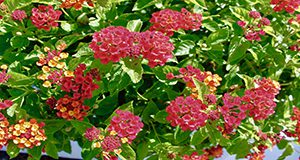 Lantana camara is a popular nursery and landscape plant in the United States; however, it is listed as a Category 1 invasive species to Florida due to its ability to hybridize with Florida’s native plant species Lantana depressa. In 2004, the UF/IFAS Gulf Coast Research and Education Center initiated a research program to develop two highly infertile L. camara cultivars, ‘Bloomify Red’ and ‘Bloomify Rose’. This five-page document discusses the production and characteristics of these cultivars. Written by Zhanao Deng and Sandra B. Wilson and published by the UF/IFAS Environmental Horticulture Department, October 2017. http://edis.ifas.ufl.edu/ep544
Lantana camara is a popular nursery and landscape plant in the United States; however, it is listed as a Category 1 invasive species to Florida due to its ability to hybridize with Florida’s native plant species Lantana depressa. In 2004, the UF/IFAS Gulf Coast Research and Education Center initiated a research program to develop two highly infertile L. camara cultivars, ‘Bloomify Red’ and ‘Bloomify Rose’. This five-page document discusses the production and characteristics of these cultivars. Written by Zhanao Deng and Sandra B. Wilson and published by the UF/IFAS Environmental Horticulture Department, October 2017. http://edis.ifas.ufl.edu/ep544
Microirrigation for Home Landscapes
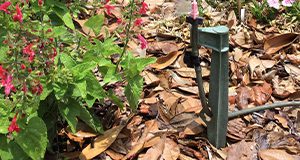 Microirrigation is a way to water plants using low pressure and low flowrates (usually 15 psi or less and 60 gph or less). Microirrigation systems can be easy to install above, on, or below the soil or mulch in landscape beds and are inexpensive to purchase. This 3-page fact sheet discusses types of microirrigation systems, benefits, design and installation, and maintenance. Written by Anne Yasalonis and Michael Dukes, and published by the UF/IFAS Department of Agricultural and Biological Engineering, October 2017.
Microirrigation is a way to water plants using low pressure and low flowrates (usually 15 psi or less and 60 gph or less). Microirrigation systems can be easy to install above, on, or below the soil or mulch in landscape beds and are inexpensive to purchase. This 3-page fact sheet discusses types of microirrigation systems, benefits, design and installation, and maintenance. Written by Anne Yasalonis and Michael Dukes, and published by the UF/IFAS Department of Agricultural and Biological Engineering, October 2017.
http://edis.ifas.ufl.edu/ae524
Soil Testing and Interpretation for Florida Turfgrasses

Most people agree that healthy, well-maintained turfgrass is a thing of beauty. The successful growth of turfgrass is aided by having knowledge of a few basic facts concerning the nutritional requirements of turfgrasses and the properties of fertilizer and liming materials. This four-page document will help the reader understand how soil testing may be used to more efficiently manage nutrient applications for Florida turfgrasses. Written by T.W. Shaddox and J.B. Sartain and published by the UF/IFAS Department of Soil and Water Sciences, October 2017.
http://edis.ifas.ufl.edu/SS317
The Cane or "Bufo" Toad (Rhinella marina) in Florida
Cane toads are an invasive species in Florida and in many countries around the world. They have been established in Florida since the 1950s. Cane toads are larger and more poisonous than Florida’s native toads; they can be fatal to dogs that try to eat them, and they may be harmful to Florida’s native species. Discover the history of cane toads in Florida and learn to distinguish them from native toads. Find out the impacts they can have on both ecosystems and people, and get tips on how to deal with them in yards and neighborhoods in this 6-page publication written by Steve Johnson and Audrey Wilson and published by the Wildlife Ecology and Conservation Department.
http://edis.ifas.ufl.edu/uw432
Managing Whiteflies on Landscape Ornamentals
Whiteflies are a common pest of many ornamental plants throughout Florida and the world. There are more than 1,500 species worldwide and over 75 reported in Florida. Although infestation does not always require treatment, it is important to be able to identify and monitor for these pests for effective integrated pest management. This 8-page fact sheet written by Eileen A. Buss, Catharine Mannion, Lance Osborne, and Adam Dale and published by the Entomology and Nematology Department describes whitefly species, their identification and biology, the damage they cause, and best management practices to control them and still maintain healthy populations of natural enemies and other beneficial insects.
http://edis.ifas.ufl.edu/mg254
Residents' Perceived Landscape Benefits Can Help Extension Promote Good Landscape Management Practices

Households can help conserve and protect water resources through irrigation and fertilizer best practices without compromising the quality of their landscape. UF/IFAS Extension, along with Extension services across the country, conducts programs to protect water quality and quantity by educating communities and individuals about research-based landscape practices. This four-page fact sheet describes the results of a survey that can help Extension promote good landscape management practices. Written by Laura A. Warner, Amanda D. Ali, and Anil Kumar Chaudhary and published by the Department of Agricultural Education and Communication.
http://edis.ifas.ufl.edu/wc282
Nematode Management in Residential Lawns
Plant-parasitic nematodes are among the least understood and most difficult pests to manage on turfgrass in Florida. They are very small, and most can only be seen with the aid of a microscope. They use a stylet to puncture plant cells, to inject digestive juices into them, and to ingest plant fluids. The most reliable way to determine whether plant-parasitic nematodes are involved in a turf problem is to have a nematode assay conducted by a professional nematode diagnostic lab. This 6-page fact sheet was written by William T. Crow, and published by the UF Department of Entomology and Nematology.
http://edis.ifas.ufl.edu/ng039
Important Resources for the Development and Sustainability of School Garden Programs
Extension agents serve as a valuable resource in providing teachers with in-service training and technical education to increase their ability to effectively use gardening as an instructional tool. This three-page document provides an outline of important resources to help in the development and sustainability of a school garden program. Written by John M. Diaz and Erin Elsberry and published by the Department of Agricultural Education and Communication.
http://edis.ifas.ufl.edu/wc283
Tools for Evaluating Soil Health
Soil health is a term synonymous with soil quality. It refers to the chemical, biological, and physical characteristics that influence a soil’s ability to function sustainably and to satisfy the needs of humans, support plants, and cycle elements, water, and energy between earth systems. This four-page fact sheet identifies ways to evaluate soil health. Written by Jehangir H. Bhadha, Jay Capasso, Robert S. Schindelbeck, and Allan R. Bacon and published by the Department of Soil and Water Sciences.
http://edis.ifas.ufl.edu/ss657
Herbicide Residues in Manure, Compost, or Hay
When purchasing compost, it is important to understand that some manure-based products can contain herbicide residues that can affect the growth of certain plants. Manure from animals that have been fed forage treated with aminopyralid or other closely related herbicides, such as clopyralid or picloram, can be contaminated with these herbicides, which severely restrict the growth of legume and solanaceous crops and other broadleaf plants. This 3-page fact sheet discusses aminopyralid, compost, questions to ask when purchasing bulk compost or mulch, conducting a bioassay, aminopyralid injury symptoms, and steps to consider if contaminated manure or compost has been added to a garden or field site. Written by Jason Ferrell, Peter Dittmar, and Brent Sellers, and published by the UF Agronomy Department, May 2017.
http://edis.ifas.ufl.edu/ag416

